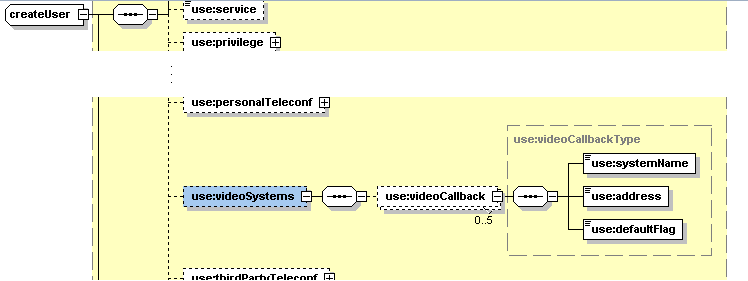Release Notes 9.0.0 SP1
Important: The XML API 9.0.0 SP1 release changes some schema definitions. For the latest schema definitions, see the release notes announcements page. The features in this release are backward compatible with previous releases.
Overview
This release note describes the changes made in the release of Webex XML API 9.0.0 SP1. These changes apply to your integration with WBS 30. All features are backward compatible with existing integrations. The changes to the latest schema definitions are explained below.
What is New in this Release
This section describes the new features in XML API 9.0.0 SP1.
- SetUser Allows videoCallback Information To Be Modified
- GetUser Allows videoCallback Information To Be Retrieved
- CreateUser Allows videoCallback Information To Be Created
SetUser Allows videoCallback Information To Be Modified
The schema for SP1 has been modified to add videoCallback information to the setUser API.
Affected APIs
SetUser
The setUser API now provides the ability to set the information for user videoCallback information.
Example Request
<?xml version="1.0" encoding="UTF-8"?>
<serv:message
xmlns:xsi="http://www.w3.org/2001/XMLSchema-instance"
xmlns:serv="http://www.webex.com/schemas/2002/06/service"
xsi:schemaLocation="http://www.webex.com/schemas/2002/06/service
http://www.webex.com/schemas/2002/06/service/service.xsd"> <header>
<securityContext>
<webExID>user1</webExID>
<password>...</password>
<siteName>...</siteName>
</securityContext> </header> <body>
<bodyContent xsi:type="java:com.webex.service.binding.user.SetUser">
<webExId>user1</webExId>
<videoSystems>
<videoCallback>
<systemName>my video 1</systemName>
<address>mv1@test.com</address>
<defaultFlag>true</defaultFlag>
</videoCallback>
<videoCallback>
<systemName>my video 2</systemName>
<address>mv2@test.com</address>
<defaultFlag>false</defaultFlag>
</videoCallback>
</videoSystems> </bodyContent> </body></serv:message>
Example Responses
If any of the video address is invalid in videoCallback or any of the address fields, the response returns with an error as follows:
<?xml version="1.0" encoding="UTF-8"?>
<serv:message
xmlns:serv="http://www.webex.com/schemas/2002/06/service"
xmlns:com="http://www.webex.com/schemas/2002/06/common"
xmlns:use="http://www.webex.com/schemas/2002/06/service/user">
<serv:header>
<serv:response>
<serv:result>FAILURE</serv:result>
<serv:reason>The video address is invalid</serv:reason>
<serv:gsbStatus>PRIMARY</serv:gsbStatus>
<serv:exceptionID>999999</serv:exceptionID>
</serv:response>
</serv:header>
<serv:body>
<serv:bodyContent/>
</serv:body>
</serv:message>
If videoSystems is in request and site CET is disabled, the response returns with an error as follows:
<?xml version="1.0" encoding="UTF-8"?>
<serv:message
xmlns:serv="http://www.webex.com/schemas/2002/06/service"
xmlns:com="http://www.webex.com/schemas/2002/06/common"
xmlns:use="http://www.webex.com/schemas/2002/06/service/user">
<serv:header>
<serv:response>
<serv:result>FAILURE</serv:result>
<serv:reason>videoSystems cannot be set because site CET is disabled</serv:reason>
<serv:gsbStatus>PRIMARY</serv:gsbStatus>
<serv:exceptionID>999999</serv:exceptionID>
</serv:response>
</serv:header>
<serv:body>
<serv:bodyContent/>
</serv:body>
</serv:message>
One defaultFlag in videoCallback must be set as true. If not set to true, the response returns with an error as follows:
<?xml version="1.0" encoding="UTF-8"?>
<serv:message
xmlns:serv="http://www.webex.com/schemas/2002/06/service"
xmlns:com="http://www.webex.com/schemas/2002/06/common"
xmlns:use="http://www.webex.com/schemas/2002/06/service/user">
<serv:header>
<serv:response>
<serv:result>FAILURE</serv:result>
<serv:reason>One defaultFlag in videoCallback must be set as true</serv:reason>
<serv:gsbStatus>PRIMARY</serv:gsbStatus>
<serv:exceptionID>999999</serv:exceptionID>
</serv:response>
</serv:header>
<serv:body>
<serv:bodyContent/>
</serv:body>
</serv:message>
Only one defaultFlag in videoCallback can be set as true. Otherwise, the response returns with an error as follows:
<?xml version="1.0" encoding="UTF-8"?>
<serv:message
xmlns:serv="http://www.webex.com/schemas/2002/06/service"
xmlns:com="http://www.webex.com/schemas/2002/06/common"
xmlns:use="http://www.webex.com/schemas/2002/06/service/user">
<serv:header>
<serv:response>
<serv:result>FAILURE</serv:result>
<serv:reason>Only one defaultFlag in videoCallback can be set as true</serv:reason>
<serv:gsbStatus>PRIMARY</serv:gsbStatus>
<serv:exceptionID>999999</serv:exceptionID>
</serv:response>
</serv:header>
<serv:body>
<serv:bodyContent/>
</serv:body>
</serv:message>
Known Issues
None.
GetUser Allows videoCallback Information To Be Retrieved
The schema for SP1 is modified to retrieve the videoCallback information through the getUser API.
The request message is not changed. You don't need to pass any new information in the request message. However, the schema of the reponse message for the getUser is changed.
Note: In the following image the
getUserReponsenow contains an element calledvideoSystemswhich contains thevideoCallbackinformation for the user. If the site is CET-enabled, the response containsvideoCallbackinformation.
Affected API
getUser
Example Response
If the site is CET-enabled, the response contains videoCallback information.
<?xml version="1.0" encoding="UTF-8"?>
<serv:message
xmlns:serv="http://www.webex.com/schemas/2002/06/service"
xmlns:com="http://www.webex.com/schemas/2002/06/common"
xmlns:use="http://www.webex.com/schemas/2002/06/service/user">
<serv:header>
<serv:response>
<serv:result>SUCCESS</serv:result>
<serv:gsbStatus>PRIMARY</serv:gsbStatus>
</serv:response>
</serv:header>
<serv:body>
<serv:bodyContent xsi:type="use:getUserResponse"
xmlns:xsi="http://www.w3.org/2001/XMLSchema-instance">
<use:firstName>John</use:firstName>
<use:lastName>Doe</use:lastName>
...
...
<use:videoSystems>
<use:videoCallback>
<use:systemName>my video 1</use:systemName>
<use:address>mv1@test.com</use:address>
<use:defaultFlag>true</use:defaultFlag>
</use:videoCallback>
<use:videoCallback>
<use:systemName>my video 2</use:systemName>
<use:address>mv2@test.com</use:address>
<use:defaultFlag>false</use:defaultFlag>
</use:videoCallback>
</use:videoSystems>
...
</serv:bodyContent>
</serv:body>
</serv:message>
Known Issues
None.
CreateUser Allows videoCallback Information To Be Created
The schema for SP1 is modified to allow videoCallback information to be included at the time a user is created through the createUser API.
Note: In the following image the
createUserelement now contains an element calledvideoSystems, which contains thevideoCallbackinformation for the user.
If the site is CET-enabled, the videoCallback information is included in the creation of the user.
If the site is not CET-enabled, the information will not be created and the response will contain an error as shown in the examples below.
Affected API
createUser
The createUser API now provides the ability to set the information for user videoCallback information.
Example Request
<?xml version="1.0" encoding="UTF-8"?>
<serv:message
xmlns:xsi="http://www.w3.org/2001/XMLSchema-instance"
xmlns:serv="http://www.webex.com/schemas/2002/06/service"
xsi:schemaLocation="http://www.webex.com/schemas/2002/06/service
http://www.webex.com/schemas/2002/06/service/service.xsd">
<header>
<securityContext>
<webExID>siteadmin</webExID>
<password>...</password>
<siteName>...</siteName>
</securityContext>
</header>
<body>
<bodyContent xsi:type="java:com.webex.service.binding.user.createtUser">
<webExId>user1</webExId>
...
...
<videoSystems>
<videoCallback>
<systemName>my video 1</systemName>
<address>mv1@test.com</address>
<defaultFlag>true</defaultFlag>
</videoCallback>
<videoCallback>
<systemName>my video 2</systemName>
<address>mv2@test.com</address>
<defaultFlag>false</defaultFlag>
</videoCallback>
</videoSystems>
...
</bodyContent>
</body>
</serv:message>
Example Response
If any of video address is invalid in the videoCallback or any of the address elements, the response returns with an error as follows:
<?xml version="1.0" encoding="UTF-8"?>
<serv:message
xmlns:serv="http://www.webex.com/schemas/2002/06/service"
xmlns:com="http://www.webex.com/schemas/2002/06/common"
xmlns:use="http://www.webex.com/schemas/2002/06/service/user">
<serv:header>
<serv:response>
<serv:result>FAILURE</serv:result>
<serv:reason>The video address is invalid</serv:reason>
<serv:gsbStatus>PRIMARY</serv:gsbStatus>
<serv:exceptionID>999999</serv:exceptionID>
</serv:response>
</serv:header>
<serv:body>
<serv:bodyContent/>
</serv:body>
</serv:message>
If videoSystems in the request and site CET is disabled, the response returns with an error as follows:
<?xml version="1.0" encoding="UTF-8"?>
<serv:message
xmlns:serv="http://www.webex.com/schemas/2002/06/service"
xmlns:com="http://www.webex.com/schemas/2002/06/common"
xmlns:use="http://www.webex.com/schemas/2002/06/service/user">
<serv:header>
<serv:response>
<serv:result>FAILURE</serv:result>
<serv:reason>videoSystems cannot be set because site CET is disabled</serv:reason>
<serv:gsbStatus>PRIMARY</serv:gsbStatus>
<serv:exceptionID>999999</serv:exceptionID>
</serv:response>
</serv:header>
<serv:body>
<serv:bodyContent/>
</serv:body>
</serv:message>
One defaultFlag in videoCallback must be set as true. If not set to true, the response returns with an error as follows.
<?xml version="1.0" encoding="UTF-8"?>
<serv:message
xmlns:serv="http://www.webex.com/schemas/2002/06/service"
xmlns:com="http://www.webex.com/schemas/2002/06/common"
xmlns:use="http://www.webex.com/schemas/2002/06/service/user">
<serv:header>
<serv:response>
<serv:result>FAILURE</serv:result>
<serv:reason>One defaultFlag in videoCallback must be set as true</serv:reason>
<serv:gsbStatus>PRIMARY</serv:gsbStatus>
<serv:exceptionID>999999</serv:exceptionID>
</serv:response>
</serv:header>
<serv:body>
<serv:bodyContent/>
</serv:body>
</serv:message>
Only one defaultFlag in videoCallback can be set as true. Otherwise, the response returns with an error as follows:
<?xml version="1.0" encoding="UTF-8"?>
<serv:message
xmlns:serv="http://www.webex.com/schemas/2002/06/service"
xmlns:com="http://www.webex.com/schemas/2002/06/common"
xmlns:use="http://www.webex.com/schemas/2002/06/service/user">
<serv:header>
<serv:response>
<serv:result>FAILURE</serv:result>
<serv:reason>Only one defaultFlag in videoCallback can be set as true</serv:reason>
<serv:gsbStatus>PRIMARY</serv:gsbStatus>
<serv:exceptionID>999999</serv:exceptionID>
</serv:response>
</serv:header>
<serv:body>
<serv:bodyContent/>
</serv:body>
</serv:message>
Known Issues
None.
Related Release Information
The XML API schemas and release notes are available at the Cisco Webex Developer Portal:
The URL API release notes are available at the Cisco Webex Developer Portal:


